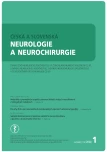Czech version of the Mini-BESTest and recommendation for its clinical use
Authors:
K. Michalčinová 1,2; J. Jeníček 2; V. Rogalewicz 2; K. Jakovcová 2; E. Kejhová 2; A. Kuželková 1,3; A. Slámová 2; Y.angerová 2
Authors‘ workplace:
Klinika rehabilitace a tělovýchovného, lékařství 2. LF UK a FN Motol, Praha
1; Klinika rehabilitačního lékařství, 1. LF UK a VFN v Praze
2; Zdravotně sociální fakulta Jihočeské, univerzity v Českých Budějovicích
3
Published in:
Cesk Slov Neurol N 2022; 85(1): 49-58
Category:
Original Paper
doi:
https://doi.org/10.48095/cccsnn202249
Overview
Introduction: There are a number of balance assessment tools available in clinical neurological and rehabilitation practice, but their use in individual workplaces within the Czech Republic varies. One of the tests is The Mini-BESTest (the Mini-Balance Evaluation Systems Test), which is clinically easy to perform, evaluates both the anticipatory and reactive postural components of stability, and has corresponding psychometric properties. Aim: The aim was to create an official Czech translation of the Mini-BESTest and propose recommendations for its clinical use in the assessment of balance in patients with chronic stroke. Methods: The official Czech version of the Mini-BESTest was created by means of back translation and verified by the author of the original test Fay B. Horak. Results and conclusion: The Czech version of the Mini-BESTest, including instructions for its administration, is now ready for routine use in the field of neurology and rehabilitation. The Mini-BESTest is a reliable and valid tool for assessing balance in patients with chronic stroke.
Keywords:
stroke – Postural control – balance – Mini-BESTest
Sources
1. Godi M, Franchignoni F, Caligari M et al. Comparison of reliability, validity, and responsiveness of the mini-BESTest and Berg Balance Scale in patients with balance disorders. Phys Ther 2013; 93(2): 158–167. doi: 10.2522/ ptj.20120171.
2. Khasnis A, Gokula RM. Romberg‘s test. J Postgrad Med 2003; 49(2): 169–172.
3. Blennerhassett JM, Jayalath VM. The Four Square Step Test is a feasible and valid clinical test of dynamic standing balance for use in ambulant people poststroke. Arch Phys Med Rehabil 2008; 89(11): 2156–2161. doi: 10.1016/ j.apmr.2008.05.012.
4. Wee JY, Wong H, Palepu A. Validation of the Berg Balance Scale as a predictor of length of stay and discharge destination in stroke rehabilitation. Arch Phys Med Rehabil 2003; 84(5): 731–735. doi: 10.1016/ s0003 - 9993(02)04940-7.
5. Horak FB, Wrisley DM, Frank, J. The Balance Evaluation Systems Test (BESTest) to differentiate balance deficits. Phys Ther 2009; 89(5): 484–498. doi: 10.2522/ ptj.20080071.
6. Hsieh CL, Hsueh IP, Mao HF et al. Validity and responsiveness of the rivermead mobility index in stroke patients. Scand J Rehabil Med Suppl 2000; 32(3): 140–142. doi: 10.1080/ 003655000750045497.
7. Horak F, King L. On the mini-BESTest: scoring and the reporting of total scores. Phys Ther 2013; 93(4): 571–575. doi: 10.2522/ ptj.2013.93.4.571.
8. Franchignoni F, Horak F, Godi M et al. Using psychometric techniques to improve the Balance Evaluation Systems Test: the mini-BESTest. J Rehabil Med 2010; 42(4): 323–331. doi: 10.2340/ 16501977-0537.
9. BESTest. [online]. Available from URL: http:/ / www. bestest.us/ .
10. Tsang CSL, Liao LR, Chung RCK et al. Psychometric properties of the Mini-Balance Evaluation Systems Test (Mini-BESTest) in community-dwelling individuals with chronic stroke. Phys Ther 2013; 93(8): 1102–1115. doi: 10.2522/ ptj.20120454.
11. Potter K, Brandfass K. The Mini-Balance Evaluation Systems Test (Mini-BESTest). J Physiother 2015; 61(4): 225. doi: 10.1016/ j.jphys.2015.04.002.
12. Lampropoulou SI, Billis E, Gedikoglouet IA et al. Reliability, validity and minimal detectable change of the Mini-BESTest in Greek participants with chronic stroke. Physiother Theory Pract 2019; 35(2): 171–182. doi: 10.1080/ 09593985.2018.1441931.
13. O’Hoski S, Winship B, Herridge L et al. Increasing the clinical utility of the BESTest, mini-BESTest, and brief - BESTest: normative values in Canadian adults who are healthy and aged 50 years or older. Phys Ther 2014; 94(3): 334–342. doi: 10.2522/ ptj.20130104.
14. Mini-BESTest: Balance Evaluation Systems Test. [online]. Dostupné z URL: http:/ / www.bestest.us/ files/ 9616/ 3761/ 1388/ MiniBESTest_Czech.pdf.
15. Podsiadlo D, Rchardson S. The timed “Up & Go”: a test of basic functional mobility for frail elderly persons. J Am Geriatr Soc 1991; 39(2): 117–228. doi: 10.1111/ j.1532 - 5415.1991.tb01616.x.
16. Davis A, Luciano M, Moghekaret A et al. Assessing the predictive value of common gait measure for predicting falls in patients presenting with suspected normal pressure hydrocephalus. BMC Neurol 2021; 21(1): 60. doi: 10.1186/ s12883-021-02068-0.
17. Lorente LC, Ríos MCG, Ledesma SN et al. Functional status and body mass index in postmenopausal women with fibromyalgia: a case-control study. Int J Environ Res Public Health 2019; 16(22): 4540. doi: 10.3390/ ijerph16224540.
18. Dominguez-Olivan P, Gasch-Gallen A, Aguas-Garcia E et al. Validity and reliability testing of the Spanish version of the BESTest and mini-BESTest in healthy community - dwelling elderly. BMC Geriatr 2020; 20(1): 444. doi: 10.1186/ s12877-020-01724-3.
19. Beauchamp MK, Niebuhr R, Roche P et al. A prospective study to establish the minimal clinically important difference of the Mini-BESTest in individuals with stroke. Clin Rehabil 2021; 35(8): 1207–1215. doi: 10.1177/ 02692155211025131.
Labels
Paediatric neurology Neurosurgery NeurologyArticle was published in
Czech and Slovak Neurology and Neurosurgery

2022 Issue 1
Most read in this issue
- Multiple tumefactive brain lesions as the first symptoms of demyelination
- Spontaneous intracranial hypotension
- Deep brain stimulation advances in neurological diseases
- Analytical and pre-analytical aspects of neurofilament light chain determination in biological fluids
